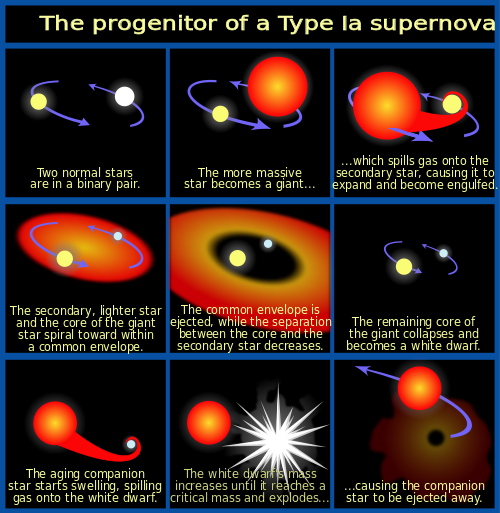So apparently a supernova is a long process... But I can't find any news about it on the web? If only my Astro teacher were to link it
This is kind of exciting that this supernova can wait a couple of days/weeks until my finals are over. And my trip to Palomar would insure the greatness of this even for me!
So anyways, with this thing going off and rated as type 1a supernova, which is the brightest of them all (When the star had enough mass to collapse it's neutron core for further reactions). Apparently this star might have had a red giant nearby to provide extra weight for the collapse:
One model for the formation of this category of supernova is a close binary star
system. The progenitor binary system consists of main sequence stars,
with the primary possessing more mass than the secondary. Being greater
in mass, the primary is the first of the pair to evolve onto the asymptotic giant branch,
where the star's envelope expands considerably. If the two stars share a
common envelope then the system can lose significant amounts of mass,
reducing the angular momentum, orbital radius and period. After the
primary has degenerated into a white dwarf, the secondary star later
evolves into a red giant and the stage is set for mass accretion onto
the primary. During this final shared-envelope phase, the two stars
spiral in closer together as angular momentum is lost. The resulting
orbit can have a period as brief as a few hours. If the accretion continues long enough, the white dwarf may eventually approach the Chandrasekhar limit.
A second possible mechanism for triggering a Type Ia supernova is the
merger of two white dwarfs whose combined mass exceeds the
Chandrasekhar limit (which is called a super-Chandrasekhar mass white
dwarf).
In such a case, the total mass would not be constrained by the
Chandrasekhar limit.
Collisions of solitary stars within our galaxy are thought to occur only once every 107-1013 yr; far less frequently than the appearance of novae. However, collisions occur with greater frequency in the dense core regions of globular clusters. (cf. blue stragglers) A likely scenario is a collision with a binary star
system, or between two binary systems containing white dwarfs. This
collision can leave behind a close binary system of two white dwarfs.
Their orbit decays and they merge together through their shared
envelope.
The white dwarf companion could also accrete matter from other types of companions, including a subgiant or (if the orbit is sufficiently close) even a main sequence
star. The actual evolutionary process during this accretion stage
remains uncertain, as it can depend both on the rate of accretion and
the transfer of angular momentum to the white dwarf companion.

No comments:
Post a Comment